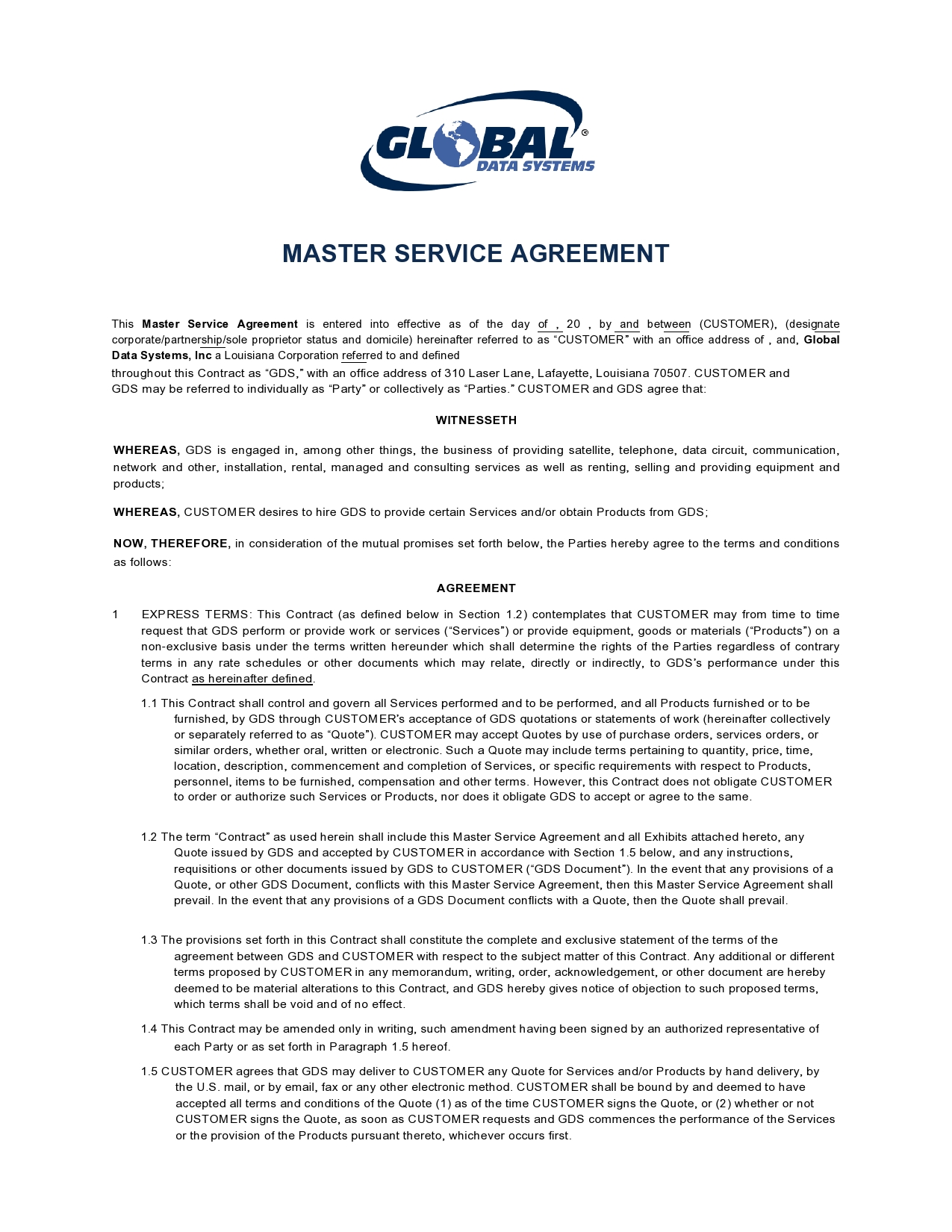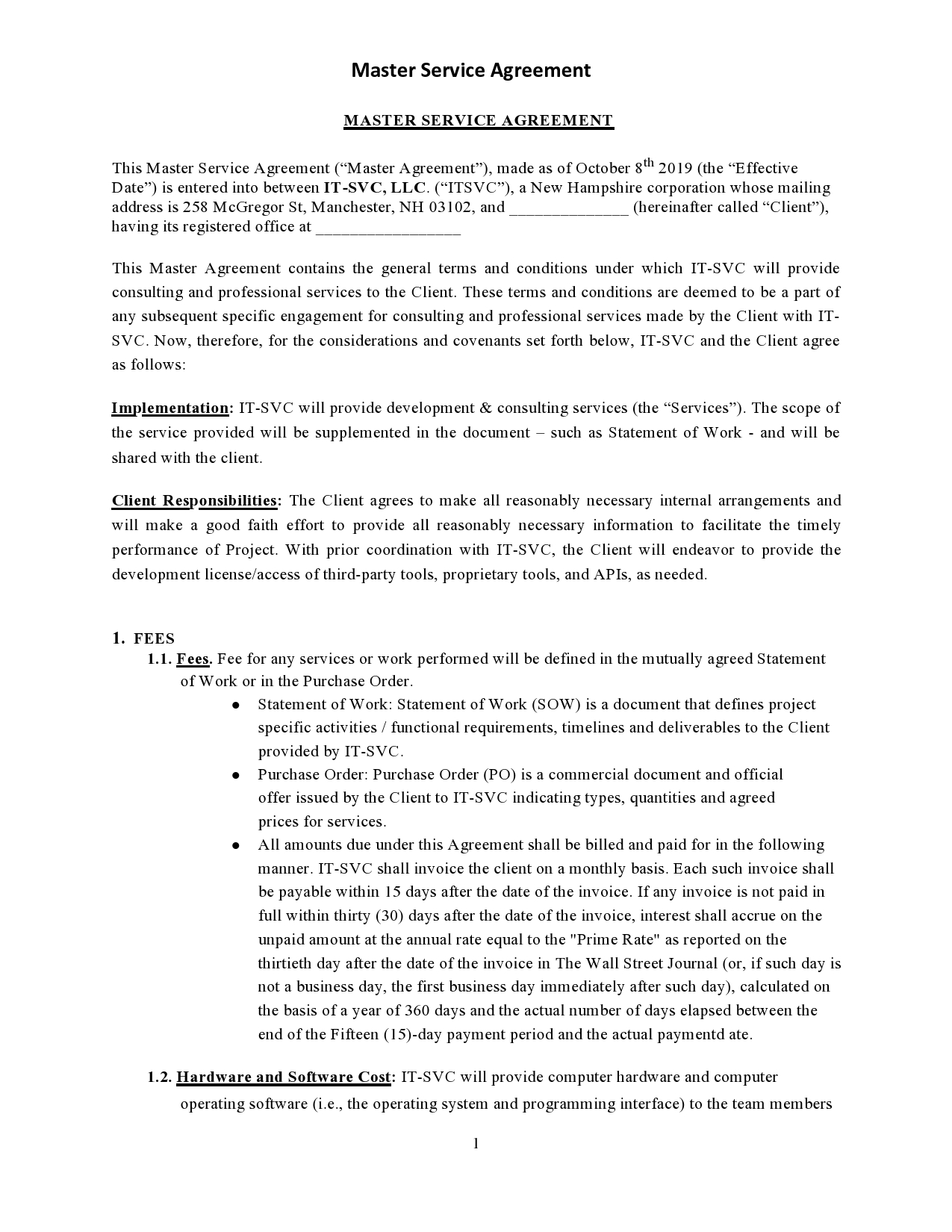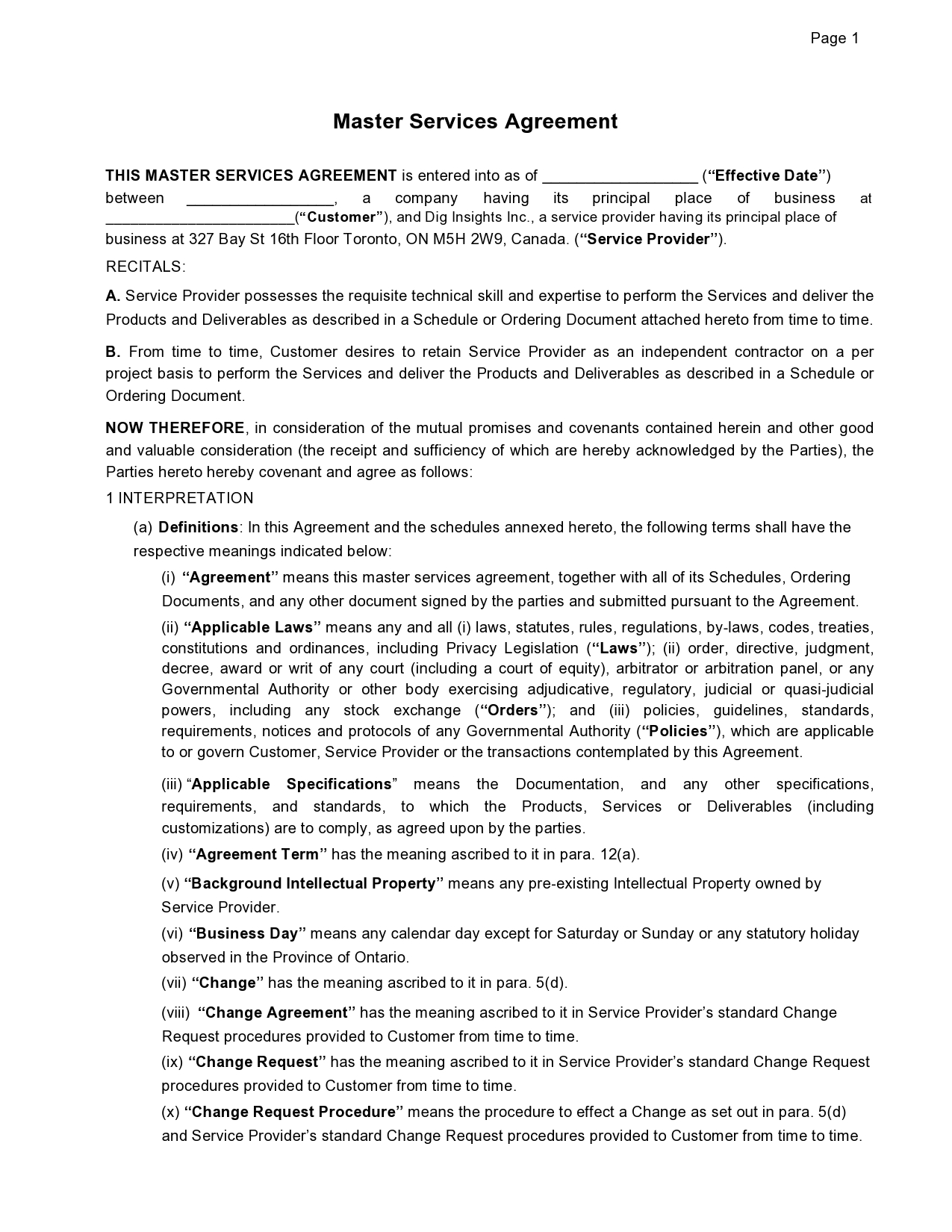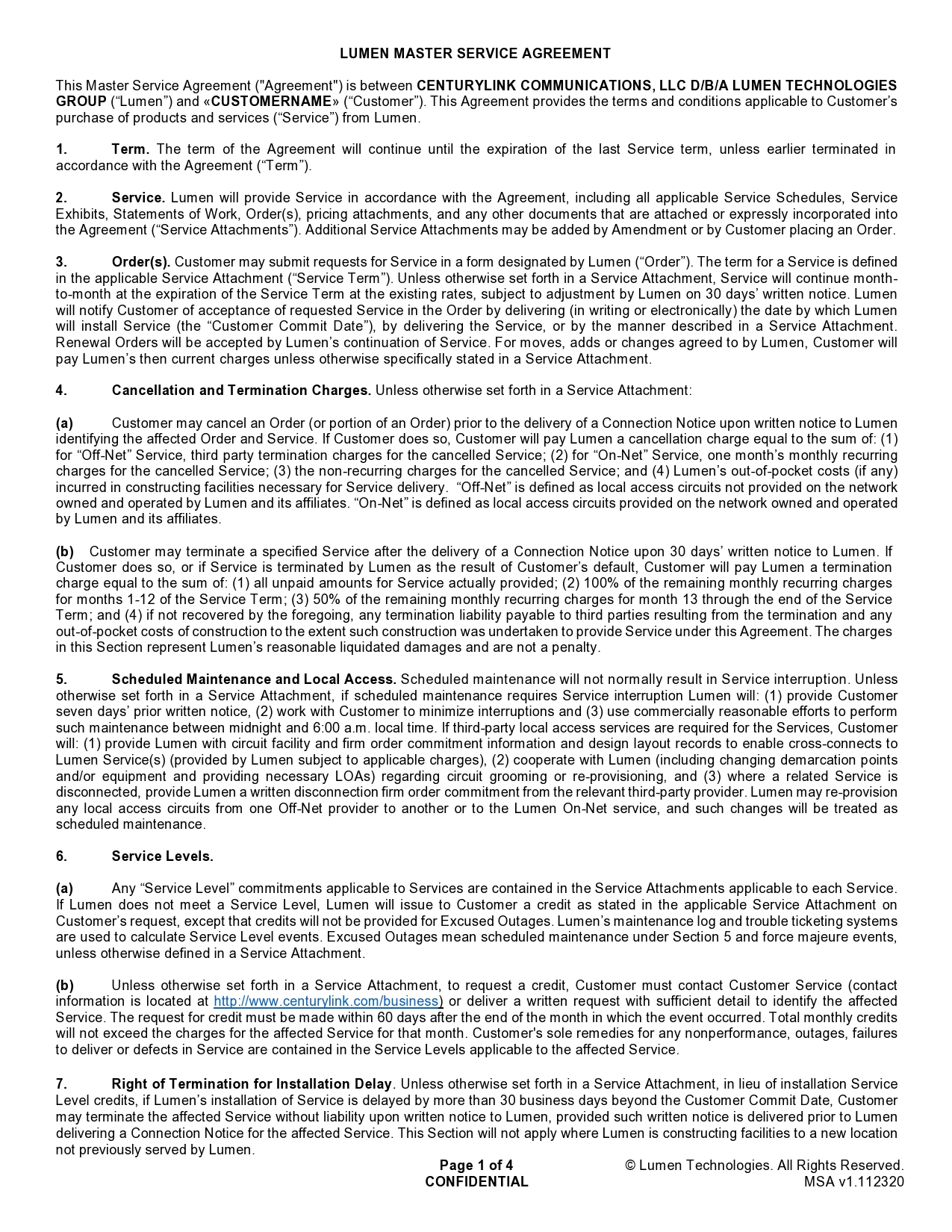A Master Service Agreement (MSA) forms the cornerstone of commercial partnerships. It streamlines complex relationships and promotes confidence in the contract. The agreement contains guidelines for brands seeking to collaborate. It is an important document that outlines the extent of the relationship including the terms. The MSA agreement is a legally binding document protecting the interests of all parties involved.
Table of Contents
- 1 Master Service Agreements
- 2 What is an MSA contract?
- 3 MSA Contracts
- 4 What goals does master service agreements template seek to fulfill?
- 5 Master Service Agreement Templates
- 6 What is in a master service agreement?
- 7 What is the difference between MSA and SLA?
- 8 Master Service Agreement Examples
- 9 What does an MSA typically include? Things to know for future agreements
It contains features such as intellectual property rights and termination procedures. The document is beneficial because it expedites the approval of subsequent commitments. It lets all parties involved make plans for the future without fear. Every clause should provide details that explain the expected commitment from each party. It should outline the consequences of breaches.
Master Service Agreements
What is an MSA contract?
An MSA contract is mainly formed between a vendor and a client. It forms the base of business relationships between them. In the agreement, the vendor agrees to supply services under the agreed terms. The client on the other hand agrees to play his role such as making payments on time.
Both parties agree on the types of warranties that cover them. They get into a mutual understanding concerning the payment terms. The document may contain guidelines for solving disagreements. Each party agrees to protect the confidentiality of the other.
Depending on the business sector, MSA agreements may differ. It depends on the type of collaboration the parties are seeking. It may also depend on the specifics each party wants to be captured in the document. A master service agreement example could be work plans that are based on specific employment conditions. Other examples may include the following.
- Agreements for offering professional services such as consultation.
- Healthcare MSAs signed between suppliers and healthcare professionals.
- Energy production and distribution MSAs cover terms such as compliance and care of the environment.
- Marketing MSAs signed between marketing promotional agencies and companies.
- Technology agreements protecting software developers and clients.
- Research agreements protecting research activities and intellectual property ownership of both parties.
MSA Contracts
What goals does master service agreements template seek to fulfill?
A master service agreement template is designed by both parties. Even if they want a consultant to do it for them, they must be present to agree on its components. Each party must contribute to the information contained therein. The contract seeks to fulfill a wide range of goals. They may include:
- Agreed sets of expectations from each party. Each party is expected to fulfill a certain action within a set timeline. They are expected to keep to certain standards. The master service agreement template seeks to explain what the timelines are. It seeks to explain what the standards are including quantities.
- The MSA agreement also seeks to have a legal compliance guide binding both parties. The goal of the legal guide is the protection of their interests.
- It seeks to define the risk mitigations that must be observed. Mitigations may include guidelines for liabilities and disputes.
- Another goal of the document is to create the terms that bind the parties. It sets the conditions that each must fulfill.
There are many more goals that an MSA contract may seek to meet. It is upon the parties to agree and set their unique goals. They may list them to act as the framework or outline of a document. The content of the agreement should be guided by the goals it’s expected to meet.
Master Service Agreement Templates
What is in a master service agreement?
An MSA agreement is a critical contract that lists the conditions of a business relationship. Its content serves the interests of everyone involved. Since the document is legally binding, its content must be within the guidelines of the law.
Before they draft the contents, the parties may seek inspiration from other MSAs. They may search and read a master services agreement sample. The ideas they get may serve as a base for the ideas to include. The document is usually detailed and defines a variety of things.
- The formation of the business relationship
The formation of the relationship defines why the collaboration was started. It explains when it started and when it will end. The question ‘why’ in a master service agreement template provides several answers.
They include names of the companies involved. It provides names of the people involved and the start date and end date of the agreement. It also notes the physical location of the parties if necessary.
The other question in the master service agreement template could be the ‘what’. It details what the agreement is about or the roles played by each party. The answers to this question may include the following.
The types of goods or services expected to be delivered or offered under the terms of the agreement.
The state or condition of the goods/services expected to be offered or delivered.
The quantities expected to be delivered or provided by the supplier.
The amount of money expected to be paid by the client.
The final question answered in the MSA agreement is ‘when’. It provides guidelines for when the contract should start. In essence, it covers the timeframes of the contract. It may include details such as:
The timeframe within which the services must be offered or goods delivered.
Expected time that must lapse before payment is made. It could be a fortnight, a month, and so on.
The type of payment expected to be received. It may include checks, cash, and so on.
The other details provide the protection that an MSA contract must offer both parties. The protection must be aligned with what the business or agreement law defines. The parties might need to read a master service agreement example. It helps them get an idea of what other parties have agreed upon before.
The master services agreement sample offers them a document to guide them. They may agree to download a predesigned master service agreement template. It makes the process easier because all that they need to do is fill in the template. The protections captured in the document include the following.
- Intellectual property rights
Intellectual property rights which offers an outline for intangible assets use. The outline offers details on how any intangible assets developed during the contract will be used. It helps in building long term business relationships between signing parties. Examples of rights may include the following.
Copyright
Patent
Logo
Data store
Software
Website domain
Trademark - Insurance
Nowadays, most products need to be insured according to law. Insurance may cover a narrow or wide area. It protects the supplier or client against things such as theft and damage due to a variety of issues. - Delays/disputes
Delays/disputes could be due to the supplier failing to deliver on time. It could also be due to the client failing to pay on time. Such delays might have a significant impact on both party’s businesses. It may have a big impact on the continued relationship or its termination. - Premature termination clause (due to dispute or to set new future contracts)
One party may decide to opt out of the agreement prematurely. The reasons for termination may differ. The MSA agreement protects one party if the other opts out prematurely. - Issues of law
The master service agreement template may define terms of governing law. The parties need to consider the different levels of law that could bind them. They may include.
Business law
Government law
Compliance law
International law
Environment law
Money transfer law - Force majeure
Force majeure protects both parties from unanticipated events or situations that each party has no control over. These are situations that may impact the capacity of the vendor or client to fulfill their role. The conditions may include times of war, floods, or fire.
Other situations could be power supply failure, government action, and snow. There might also be civil action, invasion, or an earthquake which can incapacitate one party or both to fulfill initial agreement in a timely manner or as per other set conditions.
What is the difference between MSA and SLA?
MSAs and SLAs contain guidelines for agreements between business parties. The main difference between them is the detail level of the agreement. An MSA outlines every major and minor detail. An SLA outlines the minimal benchmarks of the responsibilities of both parties. Although both agreements are different, they are compatible in many ways.
They work together to create a thorough and efficient agreement structure. The purpose of an SLA is to go deeper into the details of each component. It offers a guarantee that the products or services delivered will comply with benchmarks already in place. The purpose of MSAs is to create a strong foundational framework. It offers generalized knowledge of the agreement.
Before entrepreneurs enter into the agreements, they must understand both MSAs and SLAs. They need to know the distinctions between them. It is necessary to know the unique value each adds to the agreement. Their specific differences could be defined as follows.
- Agility
MSAs tend to be more agile. It creates a flexible environment where both parties agree on finer specifics. The agreement tends to allow adaptability where both parties may adjust the agreement if the need arises. SLAs are not agile and work in a static frame. The agreement tends to be predefined. Once signed, it doesn’t allow flexibility for adjustments or changes. - Scope
The structure of an MSA tends to be bold and wide. It covers every detail of the multifaceted aspects of the contract. Its content is generalized although it’s broad. An SLA tends to provide details of the contract specifics. It details things such as the specific elements of the products. It details the deliverables and a wide range of other finer details. - Timelines
In terms of timelines, an MSA explains what the start of the contract is. This definition covers the different phases of the contract to the end. For instance, two parties could agree to start a contract on date X.
The X becomes the base of the agreement. All timelines and phases of the contract are measured against that date. An SLA contract may have a starting date too. However, that date is not static and could be adjusted during the different phases of the contract.
Master Service Agreement Examples
What does an MSA typically include? Things to know for future agreements
Typically, an MSA contract template offers the base of contract terms. It provides the conditions governing each member of the agreement. Each party is expected to meet the conditions defined therein. For instance, one of the components could be a non-disclosure agreement.
It is an agreement binding both parties against disclosing each other’s sensitive information. It is common for businesses to contain a lot of sensitive data. The other party might have access to the data based on the contract scope. If they do, they must keep it secret all the time even after the contract ends. The entire MSA document seeks to establish a strongly binding contract.
An inclusion of all its components offers the collaborating parties a well-balanced framework for the contract. It creates space for lucidity and openness. It becomes the base for fruitful cooperation between a vendor and client. More often, the first MSA forms the starting point for future collaborations of the parties. Typically, the contract may include all or more of the following.
- Names: Names of the companies and their presentative.
- Addresses. Addresses of both parties including physical and postal or email and telephone.
- The contract. The contract defines the goods/services offered and scope.
- Payments. It defines the expected payment and the mode/s.
- Dates. Defines the timelines for deliveries, payments, and starting/termination.
- Signatures. Both parties must sign the document to prove it is a mutual contract. Some parties may go further and add the signature of an attorney.
- Stamps. The document cannot be legally binding if it lacks a stamp.
- Legal aspects. Legal aspects of the document seek to protect the parties. The details may include termination, breaching, force majeure, and confidentiality/security. It may also capture intellectual rights and resolving disputes
An MSA contract includes the details of an agreement in a business environment. It acts as the base that outlines the guidelines regulating the collaboration. It is a crucial document that offers a framework for negotiations. It establishes the platform for other agreements the parties may have in the future. The documents create expectations while reducing misunderstandings.
The clarity it presents helps with conflict avoidance and clears the path for the seamless achievement of common goals. The document’s important components include payment and delivery agreements. It outlines the conditions and other essential information guiding the parties.














































